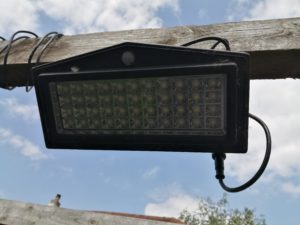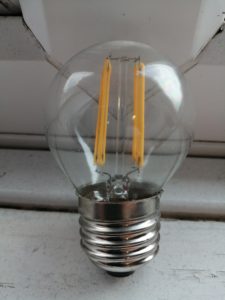Why LED Lights?
Four main advantages of LED lighting
Efficiency
|
Typically 45% to 75% saving v fluorescent
|
Reliability
|
Three to five times the design life
|
Safety |
Less occasions where the light fails
Less climbing ladders to fix failed lights Less heat given off reducing fire risk
|
Environment |
CO2 emission savings of 45% to 75%
No mercury emissions if a lamp breaks Less frequent replacement and disposal |
Should I Replace my Fluorescent Fittings with LED?
FOR
LED lights save 45% to 75% of lighting electricity consumption v fluorescent so achieving substantial electricity bill savings
LED lights last far longer and need far less maintenance than other lights substantially reducing maintenance cost
Often the capital cost is repaid in energy and maintenance savings in 1 to 2 years
AGAINST
Some disruption, and initial investment needed to make a saving
If your lighting needs regular attention, replace with good quality LED rather than repairing outdated fluorescent lights. Far better to replace all the lights in one go than have electricians regularly attending to fix sporadic faults with the existing lighting.
Cost of Ownership
- Purchase cost is not the same as cost of ownership!
- Lights have a capital cost, a running cost, and a maintenance cost – when you add these up, and share by the product lifetime, you get cost of ownership.
- On a cost of ownership basis, LED lights cost far less than any other lights!
- Also, from an environmental point of view, the LED option is more sustainable, and shows a commitment to corporate environmental responsibility.
For a friendly chat with one of our Surveyors
Free Phone 0800 298 5424
Some Numbers (Maintained Fittings)
Cost of ownership based on 24/7 operation – Microwave sensor LED v 2D fluorescent without sensor
| 2D LED Microwave 100% to 10% | 2D Fluorescent | |
| Capital cost installed | £ varies similar to fluorescent | Available still? |
| Power consumption | 16W | 30W including ballast |
| Percentage of time on | 25% | 100% |
| Annual electricity spend | £3.85 | £26.30 |
| Replacement interval battery | 3 years | 3 years |
| Replacement interval light (estimated) | 8 years | 1 year 9 months |
| Sporadic call outs | Rare | Frequent |
| Sensor suitable | Yes | Not really |
| Life of fitting | Long – very little heat | Shorter – more heat given off |
Suitability for Sensor Control
LED
LED lamps are ideally suited for sensor control and can be switched on and off tens of thousands of times without compromising their design life.
Fluorescent
Sometimes fluorescent lamps are sensor controlled. This is generally a bad idea, and seriously compromises the life of the lamp.
Metal halide, and High Pressure Sodium
Very unsuitable for sensor control – once off, have to be left off for several minutes before they can be switched on again.
For more information ...
Click on the Links for further information:
http://1stassociated.co.uk/electrics.asp
http://www.1stassociated.co.uk/articles/ceiling-lights.asp
http://www.1stassociated.co.uk/articles/homebuyers-report-or-building-survey.asp
Dimming
Maintained LED bulkhead lamps are designed to give off around 10% of their normal brightness when operating in emergency mode. This allows for a much smaller battery pack than is needed for a 2D fluorescent lamp.
When combined with a microwave sensor, the lamp can be specified to switch between 100% and 10% illumination leaving some residual illumination of stairs and corridors.
Dimming LED lamps results in linear power savings i.e. 10% brightness is achieved with 10% power consumption.
By contrast, an incandescent lamp may well require 50% of power to deliver 10% brightness!
More on Safety
Falls are one of the most common causes of workplace injury. Reduced maintenance requirements translate to less climbing ladders, and less risk of falls. The higher the fitting, the greater the advantage!
Safer for clients – with failed lights occurring less frequently, there is a less chance of stairways and corridors being inadequately lit, and consequently, less risk of litigation being brought against the company.
Fluorescent light fittings can get hot causing them to deteriorate. Occasionally, this can result in a fire. LED lights run far cooler so reducing this risk.
Fluorescent, metal halide, and sodium lamps contain mercury which can leak if a lamp breaks. No such leakage is possible from LED lamps.
Features of a Good LED Lamp
Up to date LED chips from a reputable manufacturer – such chips are reliable and of high efficiency.
A good heat sink – LED lamps last longer and are more reliable with an adequate heat sink (The cooler they run, the longer they last).
A good driver (power electronics). Often, the limiting factor on the life of an LED lamp is how long the electronics last.
The lamp is under driven – many inferior LED lamps are driven at “full throttle” this results in premature ageing and failure. By using more LED chips, and powering them more gently, lamp life is greatly extended.

LED lamps are changing
LED lamps and the electronics which drive them are improving all the time A lamp which needed 10 watts a few years ago may well need 6 or 7 watts now. This also feeds into better reliability – less heat is generated so the lamps run cooler.
The cost of LED lamps is lower than it used to be – a lamp which cost £100 four or five years ago may well be available for £25 to £30 now.
Reliability is improving – companies have matured and learned to apply better quality control procedures, and a number of reputable high quality manufacturers of reliable product have emerged.
This improvement is continuing, so if a replacement gear tray is needed, it will probably be more efficient and cost less than today. Likewise, replacement batteries will also cost less.

Why have an independent building survey?
Always have an independent building survey as this will highlight any property problems. Caveat emptor means buyer beware and is why you need to have a building survey to find out if there are any problems within the property; the estate agent certainly will not advise you of any.
Remember the building Surveyor that you employ will be the only person working for you with your interests at heart.
We would reiterate that we highly recommend you always make sure when you have a survey you meet your Surveyor at the property.

We hope you have found this article useful
We hope you found the article of use and if you have any experiences that you feel should be added to this article that would benefit others, or you feel that some of the information that we have put is wrong, then please do not hesitate to contact us (we are only human). For more information contact us on Free Phone 0800 298 5424.
The contents of the website are for general information only and is not intended to be relied upon for specific or general decisions. Appropriate independent professional advice should be paid for before making such a decision.
All rights are reserved, the contents of the website are not to be reproduced or transmitted in any form in whole or part without the express written permission of www.1stAssociated.co.uk.

